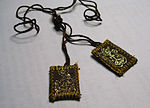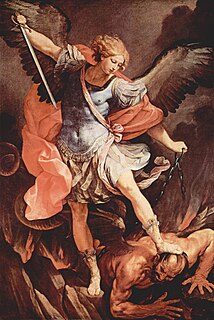Current practice
Currently, the confraternity has been extinguished and the blessing and enrollment of the scapular has fallen in the previous reserved rites, so that now it is possible for the faithful to be enrolled in this scapular by any priest.
The form of this scapular is somewhat distinct, in that the two segments of cloth have the form of a small shield; one is made of blue and the other of black cloth, and one of the bands likewise is blue and the other black. Both portions of the scapular bear the well-known representation of the Archangel St. Michael slaying the dragon and the inscription " Quis ut Deus? ", meaning Who is like God?, a translation of the Hebrew name of Michael (Mi — "who", cha — "like", el — "God"). [2] [3]
Blessing and Enrollment in the Scapular
This is the full ritual, translated into English as presented in the Weller English translation of the Rituale Romanum, for the blessing and enrollment in the Scapular of the Archangel. The priest is to be wearing a white stole.
- V. Our help is in the name of the Lord.
- R. Who made heaven and earth.
- V. The Lord be with you.
- R. And with thy spirit.
- Let us pray.
O Almighty, everlasting God, Who dost graciously defend thy Church from the wiles of the devil through St. Michael the Archangel, we suppliantly implore thee to bless † and sanctify † this token introduced for arousing and fostering devotion among thy faithful toward this great protector. And do thou grant all who wear it may be strengthened by the same holy archangel, so as to vanquish the enemies of body and soul, both in this life and at the hour of death. Through Christ our Lord.
R. Amen
The priest then sprinkles the scapular with holy water, and then bestows it, saying: Receive brother (sister), the scapular of St. Michael the Archangel, so that by his constant intercession thou mayest be disposed to lead a holy life.
R. Amen.
Let us pray. We appeal to thy goodness, O Lord that thou wouldst hear our prayers and graciously bless † this servant (handmaid) of thine, who has been placed under the special patronage of St. Michael the Archangel. Through his intercession may he (she) avoid and guard against whatever is displeasing to thee, and thus merit in serving thee to accomplish his (her) own sanctification and that of others.
Through Christ our Lord. Amen

The epiclesis is the part of the Anaphora by which the priest invokes the Holy Spirit upon the Eucharistic bread and wine in some Christian churches.

Mary, Mother of Grace is a Roman Catholic prayer to the Blessed Virgin Mary.
Confraternity of Christian Doctrine (CCD) is an association established in Rome in 1562 for the purpose of giving religious education. Its modern usage is a religious education program of the Roman Catholic Church, normally designed for children. In some Churches, CCD is called PSR, meaning Parish School of Religion.

In Eastern Orthodox and Byzantine Catholic churches, an entrance is a procession during which the clergy enter into the sanctuary through the Holy Doors. The origin of these entrances goes back to the early church, when the liturgical books and sacred vessels were kept in special storage rooms for safe keeping and the procession was necessary to bring these objects into the church when needed. Over the centuries, these processions have grown more elaborate, and nowadays are accompanied by incense, candles and liturgical fans. In the liturgical theology of the Orthodox Church, the angels are believed to enter with the clergy into the sanctuary, as evidenced by the prayers which accompany the various entrances.

Easter Saturday, on the Christian calendar, is the Saturday following the festival of Easter, the Saturday of Easter or Bright Week. In the liturgy of Western Christianity it is the last day of Easter Week, sometimes referred to as the Saturday of Easter Week or Saturday in Easter Week. In the liturgy of Eastern Christianity it is the last day of Bright Week, and called Bright Saturday, The Bright and Holy Septave Saturday of Easter Eve, or The Bright and Holy Septave Paschal Artos and Octoechoes Saturday of Iscariot's Byzantine Easter Eve. Easter Saturday is the day preceding the Octave Day of Easter.

A grace is a short prayer or thankful phrase said before or after eating. The term most commonly refers to Christian traditions. Some traditions hold that grace and thanksgiving imparts a blessing which sanctifies the meal. In English, reciting such a prayer is sometimes referred to as "saying grace". The term comes from the Ecclesiastical Latin phrase gratiarum actio, "act of thanks." In Christian theology, the act of saying grace is derived from the Bible, in which Jesus and Saint Paul pray before meals. The practice reflects the belief that humans should thank God who is the origin of everything.
Confraternities of the Cord are pious associations of the faithful, the members of which wear a cord or cincture in honour of a saint, to keep in mind some special grace or favour which they hope to obtain through his intercession.

Ave Regina Caelorum is one of four Marian antiphons, with following versicles and prayers, traditionally said or sung after each of the canonical hours of the Liturgy of the Hours. The prayer is used especially after Compline, the final canonical hour of prayer before going to sleep. It is said from the Feast of the Presentation through Wednesday of Holy Week. The origins of the prayer are unknown but it can be found included in a twelfth-century manuscript.

The Fivefold Scapular, also known as Redemptorist Scapular, is a sacramental made up of the five most popular scapulars in the Catholic Church: the Brown Scapular, the Blue Scapular, the Black Scapular, the Red Scapular, and the White Scapular.

The Gospel in Christian liturgy refers to a reading from the Gospels used during various religious services, including Mass or Divine Liturgy (Eucharist). In many Christian churches, all present stand when a passage from one of the Gospels is read publicly, and sit when a passage from a different part of the Bible is read. The reading of the Gospels, often contained in a liturgical edition containing only the four Gospels, is traditionally done by a minister, priest or deacon, and in many traditions the Gospel Book is brought into the midst of the congregation to be read.
An archconfraternity is a Roman Catholic confraternity, empowered to aggregate or affiliate other confraternities of the same nature, and to impart to them its indulgences and privileges.
Thanksgiving after Communion is a spiritual practice among Christians who believe in the Real Presence of Jesus Christ in the Communion bread, maintaining themselves in prayer for some time to thank God and especially listening in their hearts for guidance from their Divine guest. This practice was and is highly recommended by saints, theologians, and Doctors of the Church.
Vesting Prayers are prayers which are spoken while a cleric puts on vestments as part of a liturgy, in both the Eastern and Western churches. They feature as part of the liturgy in question itself, and take place either before or after a liturgical procession or entrance to the sanctuary, as depends on the particular liturgical rite or use which is being observed.

Catholic tradition and Mariology include specific prayers and devotions as acts of reparation for insults and blasphemies against the Blessed Virgin Mary. Similar prayers as Acts of Reparation to Jesus Christ and Acts of Reparation to The Holy Trinity also exist.
The usual beginning is the series of prayers with which most Divine Services begin in the Eastern Orthodox Church and those Eastern Catholic Churches which follow the Byzantine Rite.

Blessing in Roman Catholicism, in the narrow liturgical sense, is a rite consisting of a ceremony and prayers performed in the name and with the authority of the Church by a duly qualified minister by which persons or things are sanctified as dedicated to Divine service or by which certain marks of Divine favour are invoked upon them. In a wider sense blessing has a variety of meanings in the sacred writings:

Saint Michael the Archangel is referenced in the Old Testament and has been part of Christian teachings since the earliest times. In Catholic writings and traditions he acts as the defender of the Church, and chief opponent of Satan; and assists souls at the hour of death.

Among Eastern Orthodox and Eastern-Rite Catholic Christians, holy water is used frequently in rites of blessing and exorcism, and the water for baptism is always sanctified with a special blessing.
The embolism in Christian liturgy is a short prayer said or sung after the Lord's Prayer. It functions "like a marginal gloss" upon the final petition of the Lord's Prayer, amplifying and elaborating on "the many implications" of that prayer. In the Roman Rite of Mass, the embolism is followed by the doxology or, in the Tridentine Mass, by the Fraction.


















